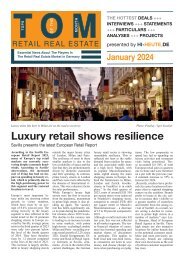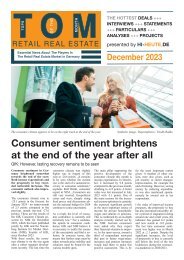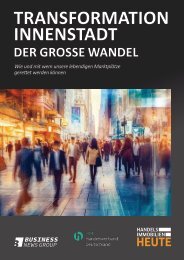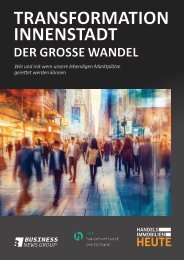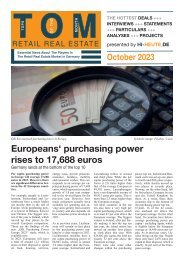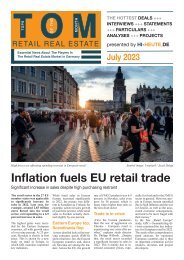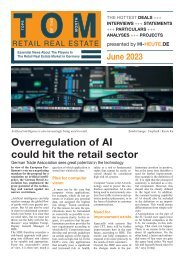TOM 04 2024
Create successful ePaper yourself
Turn your PDF publications into a flip-book with our unique Google optimized e-Paper software.
T<br />
TOPS<br />
M<br />
OF THE MONTH<br />
<strong>TOM</strong>O<br />
RETAIL REAL ESTATE<br />
TOPS<br />
OF THE<br />
MONTH<br />
Essential News About The Players In In<br />
The Retail Real Property Estate Market In in Germany<br />
THE HOTTEST DEALS +++<br />
INTERVIEWS +++ STATEMENTS<br />
+++ PARTICULARS +++<br />
ANALYSES +++ PROJECTS<br />
presented by HI-HEUTE.DE<br />
April <strong>2024</strong><br />
Special events and services are well received by customers. <br />
Incentives to buy through excellent services<br />
How retailers can emerge from the crisis<br />
What measures and services<br />
can retailers use to create new<br />
incentives to buy? The new<br />
ECC CLUB study, which analyzes<br />
the fashion and accessories,<br />
living and furnishing,<br />
consumer electronics and DIY<br />
and gardening sectors, provides<br />
the answers.<br />
In <strong>2024</strong>, half of consumers<br />
(51%) will still feel financially<br />
under pressure due to cross-sector<br />
price increases. As a result,<br />
consumer spending is being<br />
postponed, the pleasure of shopping<br />
is being lost and retailers<br />
are facing a variety of challenges.<br />
However, retailers can score<br />
points and break down barriers<br />
to purchase by offering an excellent<br />
shopping experience paired<br />
with unique services across<br />
all channels. This is shown by<br />
the results of the study „It‘s<br />
magic - with channel magic out<br />
of the crisis!“, for which more<br />
than 1,000 consumers who have<br />
purchased products from the above-mentioned<br />
areas in the past<br />
six months were surveyed.<br />
Both online and in-store, it has<br />
long been about more than just<br />
buying products. Consumers<br />
expect special experiences and<br />
still see room for improvement.<br />
This is particularly true for online<br />
purchases: for example, a<br />
third of those surveyed consider<br />
online fashion purchases to<br />
be an experience, compared to<br />
41% in the same sector in-store.<br />
Retailers have a multitude of<br />
opportunities to offer a unique<br />
experience factor, especially in<br />
the retail space. From a consumer<br />
perspective, live product<br />
demonstrations or the opportunity<br />
to test products live are<br />
particularly popular. However,<br />
gastronomic offers, workshops<br />
and events are also attractive<br />
reasons for consumers to visit<br />
stores.<br />
Regardless of the channel, customers<br />
have high expectations<br />
and the majority already expect<br />
many omnichannel services<br />
such as online availability displays,<br />
in-store returns or click<br />
& collect. Retailers who want<br />
Symbolic image: Pixabay / StockSnap<br />
to score points beyond this must<br />
offer additional services, an excellent<br />
channel link and financial<br />
benefits. Regardless of sector<br />
and shopping basket size, 72%<br />
of respondents rate the offer of<br />
a money-back guarantee as relevant<br />
for their purchase decision.<br />
Coupons, discount codes and<br />
bonus programs can also increase<br />
the willingness to buy. But<br />
services are not just about saving<br />
money: Customers are also<br />
willing to pay a premium for<br />
certain services. For example,<br />
almost one in two people (47%)<br />
say they would pay 5% more<br />
for good advice when buying<br />
furniture over the counter. Online,<br />
the willingness to pay is<br />
somewhat lower overall.
Page 2 T O M<br />
NEWS<br />
April <strong>2024</strong><br />
EDEKA breaks through<br />
70 billion euros in sales<br />
In a challenging market environment,<br />
the EDEKA cooperative<br />
network can look back<br />
on a positive business performance<br />
in 2023. Total sales<br />
across all divisions rose by 6.7<br />
percent to 70.7 billion euros,<br />
exceeding the 70 billion euro<br />
threshold for the first time.<br />
Woolworth only opened its<br />
600th store in Germany in<br />
June 2023. Less than a year<br />
later, on April 25, <strong>2024</strong>, store<br />
number 700 will follow. The<br />
company is continuing its expansion<br />
course and believes<br />
in the future of bricks-andmortar<br />
retail.<br />
With affordable everyday<br />
items, the discounter appeals to<br />
a broad target group, primarily<br />
price-sensitive shoppers. The<br />
retail concept enables Woolworth<br />
to grow further. Within a<br />
year, the discounter has opened<br />
more than 100 stores in Germany.<br />
On April 25, the company celebrates<br />
the opening of its 700th<br />
store. The milestone store is<br />
located in the Linden-Center in<br />
Berlin-Neu-Hohenschönhausen.<br />
Woolworth operates over<br />
The EDEKA Group can look back on a successful financial year.<br />
<br />
Photo: EDEKA / Thomas Schinde<br />
The core business area of the<br />
EDEKA Group is the 6,700<br />
stationary supermarkets and<br />
hypermarkets, most of which<br />
are operated by around 3,400<br />
independent retailers. In 2023,<br />
they once again demonstrated<br />
their ability to adapt creatively<br />
to changing market conditions.<br />
Over the course of the year,<br />
EDEKA entrepreneurs generated<br />
sales of 39.3 billion euros (+<br />
7.7 percent), with like-for-like<br />
sales up by almost five percent.<br />
In line with the cooperative‘s<br />
mission to promote entrepreneurship<br />
within its own ranks,<br />
the EDEKA wholesalers handed<br />
over a total of 91 self-managed<br />
stores into the hands of<br />
independent traders, 45 of them<br />
to start-ups. Over the course<br />
of the year, 122 young entrepreneurs<br />
took the step into selfemployment<br />
with their own<br />
EDEKA store. Over the past<br />
five years, the total number of<br />
start-ups amounted to 538.<br />
30 other stores in the German<br />
capital. „We have 700 stores<br />
in Germany, are continuing to<br />
expand our international store<br />
network and are extending our<br />
logistics complex and head<br />
office. So we are growing in<br />
many ways and bucking the industry<br />
trend,“ explains Roman<br />
Heini, CEO of Woolworth. „In<br />
Germany, we see potential for<br />
more than 1500 stores. We are<br />
moving quickly towards this<br />
Netto Marken-Discount also<br />
continued to develop dynamically<br />
and increased its sales to<br />
17.1 billion euros in 2023, an<br />
increase of 8.5 percent compared<br />
to the previous year (+ 7.5<br />
percent on a like-for-like basis).<br />
In 2023, 116 new Netto stores<br />
were opened across Germany<br />
and 450 locations were modernized.<br />
The group increased<br />
its investments in retail infrastructure<br />
in Germany: a total of<br />
around 2.8 billion euros was<br />
invested in IT, logistics, the expansion<br />
of production capacities<br />
and the opening of modern<br />
stores across the group.<br />
With 249 new retail locations,<br />
EDEKA (133) and Netto Marken-Discount<br />
(116) maintained<br />
their high rate of expansion.<br />
The total sales area of all<br />
11,<strong>04</strong>8 stores increased to 12.1<br />
million square meters (+ 1.1<br />
percent). Investments of around<br />
3.1 billion euros are planned for<br />
the current financial year.<br />
Woolworth reaches next milestone<br />
- already 700 German stores<br />
Woolworth is expanding significantly and will soon open its 700th<br />
store. <br />
Photo: Woolworth<br />
goal.“ The company has recorded<br />
sales of well over one<br />
billion euros and is continuing<br />
its growth course in Germany<br />
and other European countries.<br />
Woolworth has been active in<br />
Austria and Poland since 2023.<br />
Further countries will be added<br />
next year. The retail chain plans<br />
to operate 5000 stores in Europe.<br />
The discounter is headquartered<br />
in Unna, Westphalia.<br />
Ex-Kaufhof<br />
Supervisory Board<br />
Chairman Beetz also<br />
becomes new Galeria<br />
co-owner<br />
In addition to the US investment<br />
company NRDC Equity<br />
Partners, the entrepreneur Bernd<br />
Beetz will also acquire a stake in<br />
the insolvent department store<br />
chain Galeria Karstadt Kaufhof.<br />
The two companies would therefore<br />
form a consortium.NRDC<br />
and Beetz, who is president of<br />
third-division soccer club SV<br />
Waldhof Mannheim, did not respond<br />
to requests for comment.<br />
Retail sales in the<br />
eurozone fall more<br />
sharply than expected<br />
Retail sales in the eurozone fell<br />
more sharply than expected in<br />
February. They fell by 0.5 percent<br />
month-on-month, as reported<br />
by the European statistics office<br />
Eurostat in Luxembourg on Friday.<br />
Economists had expected an<br />
average decline of 0.4 percent.<br />
According to revised data, sales<br />
had stagnated in January. An increase<br />
of 0.1 percent had initially<br />
been calculated.<br />
Purchasing power<br />
<strong>2024</strong> in Germanspeaking<br />
countries:<br />
Austria the biggest<br />
winner<br />
With an average per capita purchasing<br />
power of EUR 52,566,<br />
the Swiss will once again have<br />
significantly more money available<br />
for spending and saving in<br />
<strong>2024</strong> than the inhabitants of neighboring<br />
Austria and Germany.<br />
Austrians have a per capita purchasing<br />
power of EUR 29,266,<br />
while Germans will be able to<br />
spend an average of EUR 27,848<br />
this year. However, the new GfK<br />
Purchasing Power Study <strong>2024</strong><br />
shows that there are significant<br />
regional differences in terms of<br />
net disposable income not only<br />
between countries, but also within<br />
each country.<br />
According to GfK‘s forecast,<br />
the purchasing power of Switzerland‘s<br />
more than 8.8 million<br />
inhabitants will amount to a total<br />
of 463.4 billion euros in <strong>2024</strong><br />
(excluding Liechtenstein). In<br />
Austria, the more than 9.1 million<br />
inhabitants will have a total<br />
purchasing power of around<br />
266.5 billion euros, while the<br />
total purchasing power
Page 3 T O M<br />
TOP STATEMENT OF THE MONTH<br />
April <strong>2024</strong><br />
TOP STATEMENT<br />
April<br />
„In the retail real<br />
estate industry -<br />
and not only there<br />
- there is always<br />
talk of crises. This<br />
is not really correct,<br />
because it suggests<br />
that things will be<br />
the same again after<br />
a crisis. It would<br />
be better to talk about<br />
changed framework<br />
conditions.“<br />
Sebastian Schels, Managing<br />
Partner of RATISBONA Handelsimmobilien,<br />
Regensburg
Page 5 T O M<br />
ANALYSES April <strong>2024</strong><br />
Retail on investors‘ shopping lists<br />
CBRE analysis observes optimistic mood<br />
The German retail real estate<br />
investment market grew<br />
by 15% year-on-year to EUR<br />
1.7 billion in the first quarter<br />
of <strong>2024</strong>. The asset class thus<br />
led the German real estate investment<br />
market as the most<br />
dynamic segment in the past<br />
quarter.<br />
In contrast, the share of the top<br />
seven markets in the retail real<br />
estate market declined - by eleven<br />
percentage points to 49%.<br />
The portfolio share increased<br />
by eleven percentage points, although<br />
it remained low at 23%.<br />
International investors also only<br />
had a market share of 22% (minus<br />
45 percentage points). This<br />
is the result of a recent analysis<br />
by global real estate service provider<br />
CBRE.<br />
Passable start to<br />
the year<br />
„Retail is playing a good role<br />
again and is also on the shopping<br />
list of many investors this<br />
year,“ says Jan Schönherr, Head<br />
of Retail Investment at CBRE<br />
in Germany. „The year got off<br />
to a reasonable start - given the<br />
generally challenging conditions<br />
for real estate investments.<br />
In the meantime, the price expectations<br />
of buyers and sellers<br />
have converged further, we are<br />
seeing a greater willingness to<br />
sell overall, and book values<br />
have been adjusted further over<br />
the last few months in line with<br />
market developments. On the<br />
buyer side, equity-rich family<br />
offices and pri-vate investors<br />
are currently particularly active<br />
in the city center area.“<br />
Higher footfall<br />
„The retail real estate invest<br />
ment market is benefiting from<br />
attractive yields and the end of<br />
the coronavirus debate, which is<br />
directly associated with higher<br />
footfall in city centers. In addition,<br />
consumers are once again<br />
preferring bricks-and-mortar<br />
retail to online retail in order<br />
to enjoy the shopping experience<br />
again,“ says Dr. Jan Linsin,<br />
Head of Research at CBRE in<br />
Germany. Both the ifo business<br />
climate index and the GfK consumer<br />
climate index have also<br />
The investment market for retail properties grew in the first quarter.<br />
Symbolic image: Pixabay / wal 172619<br />
recently shown positive developments.<br />
One-A properties are in demand<br />
Transaction activity was dominated<br />
by single-A retail properties,<br />
which accounted for 47%<br />
of the investment market for<br />
retail properties. In 2023, this<br />
figure was only 31%. This develop-ment<br />
is primarily attributable<br />
to two major transactions in<br />
Munich, in which the properties<br />
had a combined retail volume of<br />
around half a billion euros: Fünf<br />
Höfe and Maximilianstrasse 12-<br />
14. Food-anchored specialist<br />
stores and retail parks came a<br />
close second in the first quarter<br />
of <strong>2024</strong> - accounting for 45%<br />
(2023: 58%).<br />
Prime yields<br />
remain stable<br />
Prime yields have remained stable<br />
in all segments since the end<br />
of 2023 - although there were<br />
significant increases compared<br />
to the first quarter of 2023. The<br />
lowest prime yields were achieved<br />
by food markets at 4.7% (up<br />
0.2 percentage points), followed<br />
by single-A retail pro-perties in<br />
the top seven cities at 4.84% (up<br />
0.75 percentage points). Retail<br />
parks were at five percent (up<br />
0.5 percentage points). Shopping<br />
centers in A locations recorded<br />
a prime yield of 5.9 percent<br />
(up 0.8 percentage points)<br />
- significantly lower than shopping<br />
centers in B locations<br />
(7.2 percent, up 0.7 percentage<br />
points). „The fact that groceryanchored<br />
properties now have<br />
the lowest prime yields shows<br />
that online retail resilience can<br />
now be more important than a<br />
very good location,“ explains<br />
Anne Gimpel, Team Leader<br />
Valuation Advisory Services at<br />
CBRE in Germany.<br />
Further recovery<br />
expected<br />
„Depending on the ECB‘s interest<br />
rate decisions, we expect<br />
the retail investment market to<br />
pick up further in the coming<br />
months and especially in the<br />
second half of the year, with an<br />
in-creasing number of transactions.<br />
There are already attractive<br />
investment opportunities<br />
for in-vestors, and there will be<br />
promising investment options in<br />
all sub-retail asset classes over<br />
the course of the year,“ says<br />
Schönherr. „In terms of transaction<br />
volume in <strong>2024</strong>, we expect<br />
between five and seven billion<br />
euros by the end of the year, depending<br />
heavily on whether large-volume<br />
mixed-use sales and<br />
shopping center transactions<br />
take place and whether the portfolio<br />
market picks up.“<br />
T<br />
TOPS<br />
O M<br />
OF THE MONTH<br />
<strong>TOM</strong><br />
TOPS<br />
OPS F THE ONTH<br />
OF THE<br />
RETAIL REAL ESTATE<br />
Essential News About The Players In In<br />
The Retail Real Property Estate Market In in Germany<br />
IMPRINT<br />
MONTH<br />
Publisher:<br />
Handelsimmobilien Heute Verlagsgesellschaft<br />
mbH<br />
Address:<br />
Alexanderstraße 16<br />
45130 Essen<br />
Germany<br />
Tel. 0<strong>04</strong>9-201-874 55 28<br />
Web: www.hi-heute.de<br />
Mail: tom@hi-heute.de<br />
Frequency of publication:<br />
monthly<br />
Circulation: approx. 5000 copies<br />
sent by e-mail<br />
Editorial team: Susanne Müller,<br />
Thorsten Müller<br />
Responsible in terms of press<br />
law: Thorsten Müller<br />
Layout: K4-PR, Essen<br />
THE HOT<br />
INTERVI<br />
+++ PAR<br />
ANALYS<br />
present<br />
Marc
The art of<br />
investing<br />
Tailor-made investments in German supermarkets<br />
As real estate experts, we invest in grocery stores<br />
and retail parks throughout Germany.<br />
The advantage?<br />
Financially very strong tenants and crisis-proof basic<br />
supply ensure sustainable attractive returns for<br />
investors.<br />
20 years of experience in food retail<br />
Excellent network<br />
Working in partnership<br />
Big plans? So do we.<br />
Talk to us:<br />
Jörn Burghardt • Managing Director<br />
Phone: +49 (69) 756694334 • E-mail: j.burghardt@g-pep.com<br />
GPEP GmbH · Hamburger Allee 26-28 · 6<strong>04</strong>86 Frankfurt/Main GERMANY • www.g-pep.com
Page 7 T O M<br />
INTERVIEW April <strong>2024</strong><br />
„Neighborhood developments<br />
are not a trend topic, but a megatrend“<br />
Exclusive interview with Julia Steinmetz (Apleona Real Estate Management)<br />
Julia Steinmetz has been Managing<br />
Director and now also<br />
CEO of Apleona Real Estate<br />
Management since 2022 and is<br />
responsible for an even larger<br />
area of responsibility following<br />
last year‘s merger with<br />
FM specialist Gegenbauer.<br />
<strong>TOM</strong> editor-in-chief Thorsten<br />
Müller recently conducted the<br />
following interview with the<br />
42-year-old.<br />
<strong>TOM</strong>: Ms. Steinmetz, how did<br />
the first quarter go at Apleona<br />
Real Estate from your perspective?<br />
Julia Steinmetz: Definitely<br />
very positive. The merger with<br />
Gegenbauer and its effects<br />
naturally played a large part in<br />
this. Our company has grown<br />
considerably once again and<br />
now employs around 44,000<br />
people. A number of very good<br />
employees have also joined us<br />
in the area of property management.<br />
In general, we achieve<br />
very good scores in terms of<br />
customer satisfaction. Customers<br />
recommend us to others,<br />
which has also led to us being<br />
able to generate a major contract<br />
in the residential asset class involving<br />
around 6,700 residential<br />
units.<br />
We also have a new company,<br />
fmsc, on board. The engineers at<br />
fmsc specialize in strategic and<br />
operational property management<br />
consulting. We also have<br />
a highly competent consulting<br />
team that primarily deals with<br />
the multifaceted issues of sustainability<br />
and ESG. Apleona<br />
Real Estate Management also<br />
focuses on digitalization and the<br />
strategic expansion of its range<br />
of services. Recruitment and<br />
employee development are becoming<br />
increasingly important<br />
for all companies - we are successfully<br />
driving both forward.<br />
Fortunately, we have very low<br />
staff turnover in the company.<br />
We always try to give our employees<br />
new perspectives and<br />
thus keep them in the company<br />
for a long time.<br />
<strong>TOM</strong>: The „neighborhood“<br />
asset class has recently become<br />
much more important<br />
and will certainly continue to<br />
do so. Apleona has also been<br />
Julia Steinmetz (here at the MIPIM in Cannes). Photo: HI HEUTE<br />
working intensively on this for<br />
some time. How do you see the<br />
medium-term future in this<br />
respect?<br />
Julia Steinmetz: Neighborhoods<br />
are already seen as having<br />
great potential to meet the<br />
future challenges facing our<br />
cities. Above all, a successful<br />
neighborhood must focus on<br />
the needs of its users. Quality of<br />
stay, connectivity and the underlying<br />
concept are particularly<br />
important. But holistic management,<br />
i.e. integrated neighborhood<br />
management, is also becoming<br />
increasingly important.<br />
Together with the well-known<br />
communications agency RUE-<br />
CKERCONSULT, we conducted<br />
a survey at the end of 2023<br />
that revealed precisely these<br />
tasks and objectives. A total of<br />
94 representatives from companies<br />
in the real estate sector<br />
took part. The survey was supplemented<br />
by interviews with<br />
experts, including Dr. Thomas<br />
Beyerle, Managing Director of<br />
Catella Property Valuation, Jens<br />
Hausmann, Managing Director<br />
at Groß & Partner, Prof. Dr.<br />
Marion Peyinghaus, Managing<br />
Director of CCPMRE and Franka<br />
Jung-Larsen, Head of Retail,<br />
Center & Quartier Management<br />
at Apleona Real Estate Management.<br />
<strong>TOM</strong>: What are the most important<br />
findings and results of<br />
this survey for you then?<br />
Julia Steinmetz: A large majority<br />
of respondents share the<br />
view that districts and district<br />
developments are not a trend<br />
topic, but rather a megatrend.<br />
Urbanity, sustainability, the<br />
15-minute city and the necessary<br />
merging of complementary<br />
uses and functions will lead to a<br />
significant increase in neighborhood<br />
projects - both in new and<br />
existing buildings. However,<br />
neighborhoods place special<br />
demands on property management.<br />
This was stated by almost<br />
all survey participants. The focus<br />
here is on interest management,<br />
i.e. balancing the interests<br />
of the various user groups. Other<br />
special requirements include<br />
networking between users and<br />
the presence of the neighborhood<br />
manager on site as a local<br />
contact.<br />
<strong>TOM</strong>: What makes the difference<br />
between good and notso-good<br />
neighborhood management?<br />
Julia Steinmetz: Unfortunately,<br />
brand management and the<br />
associated emotional aspects<br />
are often neglected in the management<br />
of neighborhoods.<br />
Traditional property management<br />
alone is not enough. Different<br />
buildings, owners and<br />
users of a neighborhood must<br />
be brought together to form a<br />
whole and the urban context in<br />
which the neighborhood is embedded<br />
should not be ignored<br />
either. After all, you want to be<br />
perceived as a good neighbor.<br />
Brand management therefore<br />
includes the transparent involvement<br />
and information of<br />
users, active maintenance of<br />
the social media presence and<br />
the planning and implementation<br />
of events. All activities<br />
must be precisely aligned with<br />
the positioning of the neighborhood<br />
and any potential disturbances<br />
for users.<br />
<strong>TOM</strong>: What does Apleona<br />
deal with specifically in terms<br />
of neighborhood management?<br />
Julia Steinmetz: Among other<br />
things, we have been managing<br />
the „Tacheles“ in Berlin for<br />
some time now: this is a very<br />
good example of a neighborhood.<br />
Here, we experience in<br />
everyday life exactly what is generally<br />
perceived as a challenge<br />
in neighborhoods. The presence<br />
of a manager on site who has a<br />
feel for and knowledge of the<br />
needs of visitors and those who<br />
work there is extremely important.<br />
And of course we are constantly<br />
on the lookout for further<br />
properties, most recently at the<br />
Mipim in Cannes, where numerous<br />
cities and regions presented<br />
their construction projects.<br />
<strong>TOM</strong>: Do shopping centers<br />
also have the potential to become<br />
neighborhoods?<br />
Julia Steinmetz: In many cases,<br />
definitely yes, as do former<br />
department stores in city center<br />
locations. Here, too, it depends<br />
on the right new mix of uses.<br />
Especially where the previous<br />
business model cannot be sensibly<br />
continued, there is a huge<br />
opportunity in the transformation<br />
into a functioning district<br />
- not only for the investors concerned,<br />
but also for the city in<br />
question. This is how vacancies<br />
can be avoided and city centers<br />
revitalized.
www.wisag.de<br />
Your shopping centre in the best hands<br />
Perfect cleanliness, uncompromising security and optimum service:<br />
all this keeps not only the customers satisfied, but also tenants and<br />
owners. With our tailored solutions and experience, you will benefit<br />
from optimum management costs. And at all times, we have value<br />
retention and the sustained development of your centre in mind.<br />
We go one step further for you.<br />
Joaquin Jimenez Zabala<br />
Tel. +49 162 7861-324 joaquin.jimenez.zabala@wisag.de
Page 9 T O M<br />
NEWS April <strong>2024</strong><br />
MEC manages<br />
a further eight locations<br />
MEC is significantly expanding<br />
the portfolio of retail locations<br />
it operates. The Düsseldorf-based<br />
company has<br />
now concluded an agreement<br />
with the investment consultancy<br />
SCP Group for the management<br />
of eight German<br />
retail locations with a total<br />
rental space of around 130,000<br />
square meters.<br />
With the expansion of its portfolio,<br />
MEC now operates almost<br />
80 retail locations across Germany<br />
with a rental area of over<br />
1.7 million square meters. The<br />
mandate includes retail properties<br />
in Bochum, Duisburg, Edingen-Neckarhausen,<br />
Haßloch,<br />
Hildesheim, Kaiserslautern,<br />
Cologne and Schwerin. This includes<br />
large-scale individual locations<br />
as well as the operation<br />
of established retail parks. These<br />
include the Duisburg Mercator<br />
Center, the Sieben Seen Center<br />
in Schwerin and the Pfalz Center<br />
in Kaiserslautern.<br />
MEC will not only take over the<br />
management of the properties<br />
for SCP, but will also contribute<br />
its own leasing expertise with its<br />
broad network of retail tenants<br />
to the operation of the locations.<br />
In addition, MEC will further<br />
optimize some of the properties<br />
together with SCP.<br />
GLOBUS Markthallen is massively<br />
expanding its e-charging parks<br />
GLOBUS Markthallen is<br />
systematically expanding its<br />
charging infrastructure and<br />
thus helping to drive forward<br />
the mobility transition in Germany.<br />
To this end, the company<br />
is the first and so far only<br />
retailer to work in parallel<br />
with two charging network<br />
operators.<br />
Together with EnBW and Tesla,<br />
GLOBUS is building charging<br />
parks at around 50 market hall<br />
locations by the end of <strong>2024</strong>.<br />
This will create a total of at least<br />
800 new fast charging points for<br />
electric vehicles and the largest<br />
charging parks in the German<br />
food retail sector.<br />
Contribution to<br />
CO2 reduction<br />
The first location with charging<br />
stations from both providers has<br />
now opened at the GLOBUS<br />
market hall in Limburg, Hesse.<br />
Customers will have 16 EnBW<br />
fast-charging stations and ten<br />
Tesla charging points at their<br />
disposal from the start.<br />
Düsseldorf-based MEC now manages eight retail locations for the<br />
investment consultancy SCP, including the Sieben Seen Center in<br />
Schwerin. <br />
Photo: MEC<br />
The first location with charging stations from both providers has<br />
opened at the GLOBUS market hall in Limburg. Photo: GLOBUS<br />
„We see the improvement of<br />
the charging infrastructure at<br />
our market halls not only as<br />
our contribution to the mobility<br />
transition and part of our commitment<br />
to sustainability,“ says<br />
Thomas Hewer, CEO of GLO-<br />
BUS Markthallen.<br />
„Our customers in particular<br />
benefit from a safe, convenient<br />
and, above all, affordable charging<br />
service at all times.“ „Fast<br />
charging at retail outlets makes<br />
e-mobility easy for everyone,“<br />
says Jürgen Stein, Chief Innovation<br />
& New Business Officer<br />
at EnBW and responsible for e-<br />
mobility. „While customers are<br />
shopping, they can charge their<br />
car with enough range for the<br />
next few days. GLOBUS is therefore<br />
a key partner in the further<br />
expansion of what is already<br />
Germany‘s largest fast-charging<br />
network and for the convenient<br />
charging of e-cars in everyday<br />
life. Together with GLOBUS,<br />
we are driving forward more<br />
sustainable mobility and helping<br />
to reduce CO2 emissions in<br />
transportation.“<br />
Opening of<br />
Überseequartier<br />
postponed to the<br />
end of August<br />
The Westfield Hamburg-<br />
Überseequartier was originally<br />
due to open its doors at<br />
the end of the month, but due<br />
to water damage, the opening<br />
has had to be postponed at<br />
short notice.<br />
The real estate company Unibail-Rodamco-Westfield<br />
has<br />
announced that the opening,<br />
originally scheduled for April<br />
25, will be postponed to the<br />
end of August. In the basement<br />
of the shopping center,<br />
which is still under construction,<br />
there has been a local<br />
ingress of groundwater in<br />
the area of a central technical<br />
system, which means that it<br />
cannot be put into operation<br />
in the short term.<br />
Analysis of the damage has<br />
begun. In view of the seasonal<br />
retail calendar and the<br />
summer vacations, which this<br />
school year in Hamburg run<br />
from July 18 to August 28, the<br />
new date, which is still vague,<br />
has been chosen.<br />
More than 70<br />
Galeria stores<br />
to be kept open<br />
The new owners of Galeria<br />
Karstadt Kaufhof want to get<br />
the insolvent department store<br />
chain back on the road to success.<br />
„We believe in the future<br />
of Galeria and have only<br />
one focus: the department<br />
store,“ said investor Bernd<br />
Beetz yesterday lunchtime in<br />
Essen. The department store<br />
is part of the German way<br />
of life. Together with the US<br />
investment company NRDC,<br />
the 73-year-old is forming a<br />
consortium that wants to take<br />
over Galeria.<br />
The new owners would probably<br />
continue to operate<br />
more than 70 of the current<br />
92 stores, said insolvency administrator<br />
Stefan Denkhaus.<br />
This figure is part of the investor<br />
agreement, which was<br />
notarized on Tuesday. We already<br />
reported yesterday that<br />
Beetz and NRDC were to win<br />
the bid in the bidding process<br />
(and have since done so).
URBAN CREATORS.<br />
Architecture | Development & Project Management<br />
European Council of Shopping Places (ECSP) Awards: Commendation for Best Renovation/Expansion for centres between 15.000 – 45.000 sqm
Page 11 T O M<br />
CENTERS April <strong>2024</strong><br />
From mixed-use to events, many shopping centers are looking for concepts to position themselves for the future.<br />
<br />
Symbolic image: Unsplash / Krisztina Papp<br />
Shopping centers reposition themselves<br />
White paper sheds light on the situation of the asset class<br />
Shopping centers find themselves<br />
in a challenging competitive<br />
environment. Global<br />
crises and war situations are<br />
driving up costs, unsettling<br />
customers and resulting in a<br />
reluctance to spend while at<br />
the same time reducing rental<br />
income.<br />
Despite the difficult waters,<br />
center managers are trying to<br />
develop solutions to make their<br />
centers fit for the future. Mixeduse<br />
is already a proven trend, as<br />
are measures such as increased<br />
and cost-saving energy efficiency<br />
and attractive events.<br />
Decline in rental<br />
volume<br />
„Of course, these can be sensible<br />
measures to combat vacancies<br />
and declining visitor frequency.<br />
However, it is impressive to see<br />
the different lines of development<br />
that are emerging in shopping<br />
centers,“ says EHI study<br />
author and retail real estate expert<br />
Lena Knopf, explaining the<br />
results of the white paper „Center<br />
Management in Focus“ by<br />
EHI and GCSP.<br />
In a clear majority of around<br />
two thirds of centers, the rental<br />
volume (excluding ancillary<br />
costs) declined between 2021<br />
and 2023. The two main reasons<br />
for this are subsequent lettings<br />
with lower rents to retailers and<br />
rent reductions on existing contracts.<br />
Events increase<br />
attractiveness<br />
Only in the more recent centers<br />
built after 2010 did the proportion<br />
with increased rental income<br />
outweigh the proportion<br />
with decreased rental income.<br />
The centers with retail space of<br />
between 30 and 40,000 square<br />
meters performed the worst.<br />
The smallest centers with ten to<br />
20,000 square meters of retail<br />
space performed best, with the<br />
lowest proportion of decreased<br />
rental income and the highest<br />
proportion of increased rental<br />
income. Increased mixed-use<br />
concepts such as leisure facilities<br />
or medical services are attracting<br />
new tenants to shopping<br />
centers.<br />
Events are an established measure<br />
to increase the attractiveness<br />
of a shopping center and<br />
strengthen customer loyalty.<br />
Seasonal occasions such as<br />
Christmas or Easter (93%) promise<br />
the greatest success, followed<br />
by fun events suitable for<br />
families (73%). Overall, many<br />
centers (43%) are organizing<br />
fewer events than before the<br />
pandemic or the same number<br />
(46%). The larger centers are in<br />
the lead. The smaller the center,<br />
the more difficult it is to host<br />
many successful events. Every<br />
second small center under<br />
20,000 square meters reduces<br />
the number of events, but only<br />
around one in three large centers<br />
with 40,000 square meters<br />
or more.<br />
Frequency and<br />
turnover<br />
Visitor frequency - often measured<br />
using video, light or laser<br />
technology - has fallen in 54%<br />
of shopping centers compared<br />
to the pre-coronavirus level in<br />
2019, but 30% have observed<br />
a constant frequency and only<br />
16% are happy about more customers.<br />
However, retail sales<br />
are looking slightly better. At<br />
35%, they are higher or even<br />
significantly higher, and at 29%<br />
they are at a similar level - even<br />
though this growth is currently<br />
accompanied by relatively high<br />
inflation rates, which means that<br />
many retail sectors have been<br />
able to increase their sales in<br />
nominal terms but not in real<br />
terms.<br />
Often moderate<br />
vacancy rate<br />
More than half of the centers<br />
(57%) have a moderate vacancy<br />
rate of up to 5% of the retail rental<br />
space. A good third (34%) of<br />
centers even have a low vacancy<br />
rate of up to 3% this year, although<br />
this was almost twice as<br />
many (66%) in 2019. The proportion<br />
of centers with vacancies<br />
of more than five percent<br />
has more than doubled from 19<br />
percent in 2019 to 44 percent in<br />
<strong>2024</strong>.
Increase visibility, reduce risk<br />
& enable team collaboration<br />
within a single connected<br />
solution<br />
OPTIMISE RETAIL REVENUE<br />
Yardi Elevate is designed for asset managers, leasing executives & operational<br />
managers for all types of commercial real estate to enhance performance<br />
• Drive new deals and enhance revenue<br />
• Work with detailed lease and financial data in<br />
real time<br />
• Streamline forecasting & model scenarios<br />
• Reduce friction & centralise team collaboration<br />
• Minimise risk & increase value<br />
+49 (0) 6131 14076 3<br />
Learn with us at yardi.de/products/elevate<br />
Get<br />
the<br />
details<br />
©2022 Yardi Systems, Inc. All Rights Reserved. Yardi, the Yardi logo, and all Yardi product names are trademarks of Yardi Systems, Inc.
Page 13 T O M<br />
GUEST CONTRIBUTION April <strong>2024</strong><br />
How bricks-and-mortar retailers<br />
can find and retain footfall<br />
Guest article by Dr. Philipp Hoog, Member of the Management Board of BBE, Munich<br />
In <strong>2024</strong>, the retail sector still<br />
faces two all-too-familiar but<br />
all the more present challenges.<br />
Firstly, despite a noticeable<br />
recovery in some areas,<br />
footfall in the city center is still<br />
not back to pre-coronavirus<br />
levels. Above all, tourists with<br />
purchasing power are missing.<br />
This is result-ing in more<br />
and more stores closing, and it<br />
is realistic to assume that we<br />
will lose around 20 percent of<br />
all city center retail tenants in<br />
the medium term. Secondly, e-<br />
commerce is putting pressure<br />
on retailers with a wide range<br />
of goods and a rather vaguely<br />
defined target group in particular<br />
- because it almost inevitably<br />
creates price advantages<br />
to the detriment of bricksand-mortar<br />
retailers.<br />
What should retailers do against<br />
this backdrop? The most important<br />
aspect of a successful<br />
re-tail space is a clear profile<br />
with a defined target group, a<br />
carefully curated product segment<br />
and motivated staff with a<br />
high level of advisory skills.<br />
However, in order for these<br />
advantages to come to fruition<br />
in the first place, the lower frequency<br />
must be optimally exploited.<br />
In other words: where<br />
there is a lack of quantity, retailers<br />
should focus on quality. It<br />
is therefore important to attract<br />
passers-by into the stores with<br />
modern drive-to-store strategies<br />
- and to stimulate purchases.<br />
„Drive to store“<br />
combines online<br />
with offline<br />
The starting position for this is<br />
better than expected: In a survey<br />
recently conducted by BBE,<br />
it emerged that city centers are<br />
becoming more popular again,<br />
especially among younger people.<br />
According to the survey,<br />
around 43 percent of under-24s<br />
visit the city center more often<br />
than five years ago. The most<br />
frequently cited reason was<br />
„shopping“. However, new means<br />
are needed to get to grips<br />
with the old challenges.<br />
Dr. Philipp Hoog <br />
Online and offline retail have<br />
long since merged in many respects.<br />
Customers do not differenti-ate<br />
between the channels,<br />
which is why retailers should<br />
also focus on a mixture when<br />
addres-sing them. This can be<br />
seen very clearly in modern drive-to-store<br />
measures, the aim<br />
of which is the aforementioned<br />
frequency skimming.<br />
These include regional newsletters,<br />
selected discount campaigns<br />
for which the customer<br />
has to come into the store, or a<br />
Google page with lots of positive<br />
reviews (which retailers are<br />
also allowed to ask their customers<br />
for). The now established<br />
click-and-collect system also<br />
Photo: BBE<br />
attracts customers to the store,<br />
where the chance of additional<br />
impulse purchases is very high.<br />
Aug-mented reality allows products<br />
to be experienced in a<br />
virtual environment - and also<br />
impresses with an undeniable<br />
coolness factor. An important<br />
side effect: all these measures<br />
generate a huge amount of data,<br />
which in turn can be used by retailers<br />
to get to know their own<br />
customers even better. This in<br />
turn allows target groups to be<br />
further honed and product ranges<br />
to be put together even better.<br />
The creative use of social media<br />
also has enormous potential.<br />
It‘s less about posting regularly<br />
- and more about creating incentives.<br />
A salesperson who films<br />
the „unboxing“ of new goods<br />
and posts it on TikTok is the best<br />
example. An Instagram reel that<br />
invites people to a fashion show<br />
in the store combines modern<br />
online communication with an<br />
event in the store that stands<br />
for the quality of experience in<br />
stationary retail. If the event is<br />
then filmed and later appears<br />
in the timeline, the synthesis of<br />
the online and offline worlds is<br />
perfect. Another way to attract<br />
new customers to the space is<br />
to cooperate with other local<br />
businesses. After all, the perfect<br />
eve-ning outfit also needs the<br />
right perfume, right?<br />
It is important to emphasize that<br />
none of these measures is a universal<br />
solution in itself. Each<br />
retailer should set their own<br />
priorities and plan their implementation<br />
carefully. Continuous<br />
market observation and the ability<br />
to adapt to new trends are<br />
fundamental.<br />
These are the prerequisites for<br />
a holistic concept that clearly<br />
sets the retailer brand and the<br />
„look and feel“ apart from the<br />
competition. It‘s not just about<br />
being as pleasant as possible for<br />
customers - now more than ever,<br />
it‘s important for retailers to be<br />
distinctive.<br />
Conclusion: More<br />
experience per<br />
square meter<br />
Sales area productivity equals<br />
sales per unit of time divided<br />
by pure sales area. This wellknown<br />
formula for the key figure<br />
„sales persquare meters“ still<br />
dominates the analyses of many<br />
retailers. However, modern<br />
stationary retail thrives on the<br />
„experience per square meter“.<br />
This can even go as far as converting<br />
indi-vidual areas in the<br />
store and integrating a gastronomic<br />
offering, for example. For<br />
a sports retai-ler, on the other<br />
hand, it can make sense to set<br />
up one or two fitness machines.<br />
The result is satisfied customers<br />
who enjoy the experience and<br />
are all the more likely to buy.
PREMIUM ECO SERIES<br />
50% LESS<br />
ENERGY<br />
same look & quality<br />
WE MAKE PEOPLE HAPPY.<br />
-50% *<br />
FOR<br />
MORE<br />
INFO<br />
*compared to the classic LED
Page 15 T O M<br />
INNOVATIONS April <strong>2024</strong><br />
ALDI SOUTH relies on<br />
gamification to find applicants<br />
With its new digital HR campaign,<br />
ALDI SOUTH is focusing<br />
on gamification in its<br />
search for experts in sales. The<br />
company is now immersing itself<br />
in the world of gaming under<br />
the motto „Level up“ and<br />
using familiar game elements<br />
that allow users to get to know<br />
everyday working life in the<br />
store in a playful way.<br />
According to a recent study by<br />
Bitkom Research, it is not only<br />
the younger target group between<br />
the ages of 16 and 29 who<br />
regularly play computer or video<br />
games in everyday situations.<br />
74 percent of 30 to 49-year-olds<br />
and 46 percent of 50 to 69-yearolds<br />
also have a preference for<br />
the gaming world. With the new<br />
HR campaign, ALDI SOUTH<br />
is addressing precisely this target<br />
group and at the same time<br />
making everyday working life<br />
in sales virtually more tangible.<br />
„As part of the core business,<br />
my heart naturally beats for sales,“<br />
says André Giesen, Group<br />
Director Human Resources at<br />
ALDI SOUTH. „At the ALDI<br />
SOUTH Group, sales activities<br />
are diverse and talent is not only<br />
recognized, but also encouraged<br />
and valued. Having fun at work<br />
is particularly important to us,<br />
ALDI SOUTH is looking for new applicants in innovative ways. Photo: ALDI SOUTH<br />
as this is the only way to fully<br />
utilize individual skills and performance.“<br />
In order to achieve the greatest<br />
possible attention, the campaign<br />
will be played out in the form of<br />
various clips on outdoor screens<br />
and via Connected TV on Netflix<br />
and Prime Video as well<br />
as on YouTube. In addition,<br />
Instagram users can try out the<br />
campaign‘s gaming filter on the<br />
ALDI SOUTH careers channel<br />
for the first time and playfully<br />
prove their skills at the checkout.<br />
In this way, ALDI SOUTH<br />
wants to address the target<br />
group exactly where they are.<br />
This is because almost 35 percent<br />
of potential applicants<br />
search for jobs or career-related<br />
information on Facebook and<br />
30 percent on Instagram. This is<br />
how the ALDI SOUTH Group<br />
aims to counteract the shortage<br />
of skilled workers in its stores.<br />
The media agency PHD Germany<br />
and the HR marketing<br />
agency EMBRACE are responsible<br />
for the employer branding<br />
campaign.<br />
Smart shopping carts<br />
instead of „Just Walk Out“<br />
According to a report by<br />
technology portal The Information,<br />
Amazon wants to say<br />
goodbye to its „Just Walk<br />
Out“ cashierless supermarkets.<br />
Instead, Amazon dash<br />
carts, i.e. self-checkout tills<br />
converted into shopping carts,<br />
are to be used in most stores.<br />
When customers place goods<br />
from the shelf into the shopping<br />
cart, these products are automatically<br />
scanned and added<br />
to the bill. The process can be<br />
controlled via a touchscreen<br />
on the handle of the Dash Cart.<br />
Amazon has now confirmed the<br />
switch to smart shopping carts<br />
at Amazon Fresh locations in<br />
Amazon wants to change the technology in its supermarkets.<br />
Photo: AdobeStock<br />
the USA: „Just Walk Out“ will<br />
initially only be used in a small<br />
number of Fresh stores in the<br />
UK and in some Amazon Go<br />
supermarkets.<br />
Background: With the Just Walk<br />
Out technology, a complex camera<br />
system recorded every<br />
inch of the supermarket. However,<br />
instead of fully automated<br />
computer monitoring, more<br />
than 1,000 people in India are<br />
to evaluate the exceptions and<br />
mark them manually.<br />
The cashiers were therefore<br />
removed from the store and<br />
placed elsewhere on the globe,<br />
from where they observed the<br />
customers. According to The<br />
Information, around 700 out of<br />
1000 purchases had to be analyzed<br />
in this way because the system<br />
was unable to do so. This is<br />
well below Amazon‘s original<br />
target of 50 out of 1000 visits.
Page 16 T O M<br />
MAP OF THE MONTH April <strong>2024</strong><br />
GfK Purchasing Power for Germany, Austria and Switzerland <strong>2024</strong><br />
GfK’s Map of the Month for April shows the regional distribution<br />
of purchasing power in Germany, Austria and<br />
Switzerland in <strong>2024</strong>. With an average per capita purchasing<br />
power of €52,566, the Swiss once again have significantly<br />
more money available for spending and saving in<br />
<strong>2024</strong> than the inhabitants of Austria and Germany. Austrians<br />
have a per capita purchasing power of €29,266, while<br />
Germans can spend an average of €27,848 this year. However,<br />
there are significant regional differences in terms of<br />
net disposable income not only between countries, but also<br />
within each country. In Switzerland, the district of Hoefe<br />
in the canton of Schwyz takes first place by some distance.<br />
People there have an average of €131,932 at their disposal,<br />
which is more than 3.4 times as much as the inhabitants<br />
of Bernina, the region with the lowest purchasing<br />
power (€38,590). Among Austrians, Vienna‘s 1st district<br />
(inner city) is in the lead with a per capita purchasing power<br />
of €42,495, while Vienna‘s 20th district (Brigittenau)<br />
brings up the rear with €23,371. In Germany, the district<br />
of Starnberg leads the district ranking with a per capita<br />
purchasing power of €38,702; Gelsenkirchen comes last<br />
with a spending potential of €22,007 per inhabitant.







